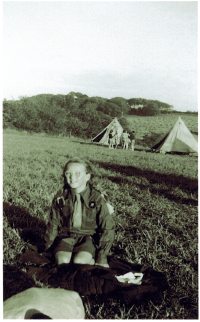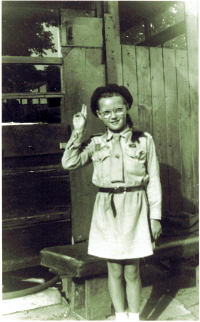|
The Pucklechurch community website |
|||||||||||||||
|
|
|||||||||||||||
|
Click here |
|||||||||||||||
|
If you are not receiving emails please check the following: |
|||||||||||||||
 |
||
|
On this page |
||
|
An edited version of this article appeared in the Autumn 2012 edition of Pucklechurch News. Our own Ros Abbott celebrated a major milestone recently. Yes, yes, she did have one of those big-0 birthdays in June, but this milestone was much rarer. Ros received an award from Girlguiding UK for 50 years of volunteer service to guiding. In truth, though, she’s been involved with guiding one way or another since 1950. Ros was seven or eight when some other girls told her about a fantastic "club" they belonged to. She was so excited that she ran home from school, forgetting to collect her little brother first. Though her mum was not amused about her lapse, Ros was allowed to join Brownies. The vicar’s daughter led the unit in Stratford-upon-Avon, where Ros’s family lived. "Miss Melville was just what you might expect: an upright, unmarried woman with a keen sense of discipline," says Ros. The attraction for Ros was Guide Camp. Since her parents ran a leisure boating business serving the Shakespeare tourists who came to Stratford, the family never took summer holidays. The prospect of going away to the seaside for a week was thrilling to young Ros. She learned how to make a bed roll from blankets fastened together with safety pins and never looked back. The Brownies went off in the back of a furniture van loaded with camping equipment. No permission slips, no seat belts, no adults (who were riding up front in the comfort of the cab). When they got to camp, the girls slept in canvas bell tents like the army used, and there were no modern conveniences. The toilets were trenches with spades, and bathing facilities consisted of wash cubicles made of hessian strung between poles. The girls warmed themselves by wood fires, which the quartermaster also used to cook the food in dixies, enormous cast-iron pots placed on the fire. It was great! At 11, Ros moved up into Guides. Today’s Guides would be surprised at some of the skills girls learned in the 1950s, like how to turf a fire pit and light a fire that leaves no trace. The Guides were taught how to chop wood with an axe and whittle with a knife. They even made their own wooden tent pegs! And in the days when most homes did not have a telephone, the girls learned how to make a call from a public phone box. The achievements for earning a first-class guiding award included reading a map, using a compass and finding the 16 points by the sun and stars, organising a half-day expedition for two other Guides (without an adult), darning a stocking, and knowing how to resuscitate a drowning victim.
Various parts of the uniform had dual purposes. The Guides were taught how to use their ties as bandages and slings. Ros showed me her old belt, which had the inches and feet marked off on the reverse side so it could be used as a measuring tape. When she was 15, Ros’s family moved to Marshfield, where her father took over the post office. She joined the Marshfield Guides unit. When she turned 16 and could no longer be a Guide, Ros stayed on as a helper. When the unit’s leader became ill, Ros took over running the unit temporarily. Unfortunately, the leader never came back, so temporary became permanent, though she was officially too young to be a leader. When she was 18, the District Commissioner Mrs Davison, who lived in the Moat House in Pucklechurch, asked Ros to become a lieutenant. Now as an official leader, she took her Guides off to Badminton Cottages for a weekend without a second thought. In those days, there were no CRB checks for leaders and no training. Fortunately, there were no disasters either. Ros tells me that guiding was quite different in the 1950s and ‘60s from what it is today. It was run along military lines, with rules and discipline at its core. The emphasis today is very much on having fun, rather than the focus on practical skills and public service of yesteryear. Today’s Guides are encouraged to learn about the world outside their own country and gain an appreciation of what girls’ lives are like in different places. The Guides of the ‘50s couldn’t imagine getting on a coach to London to go to a pop concert at the O2 Arena. Guides still do fundraising for good causes, of course, and becoming a good citizen is still at the heart of guiding. One of the presents Ros received for her recent birthday was a blue plaque similar to those used in London to mark houses where famous people have lived or worked. Her daughter had one made for her. It reads, “Ros Abbott, the world’s longest serving Girlguider”. [Please correct wording, Ros] It may not be quite true, but it is a fitting tribute to someone who has touched the lives of thousands [?] of girls over five decades of volunteer service. Thank you, Ros, from all of us.
|
||
|
How Things Have Changed! The 1954 edition of the Guides’ official publication of Hints on Girl Guide Tests lists the following requirements for being a First Class Guide:
Throughout the test, the candidate’s appearance, carriage, courtesy, and common sense shall be taken into consideration. The remainder of the chapter on the First Class test goes on to give girls practical advice on such things as stuffing newspaper under their coats to keep warm, measuring the width of a river using a marker pole and paces, cleaning their cooking pots with wood ash, identifying the correct pressure point to reduce bleeding in a wound, and what to do if they fall through the ice on a lake or river. How about it, girls?
|
||

